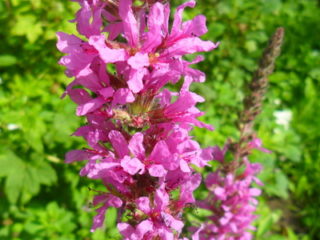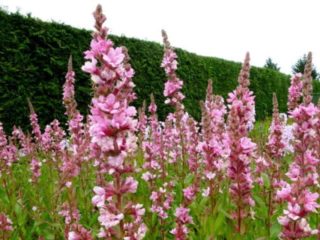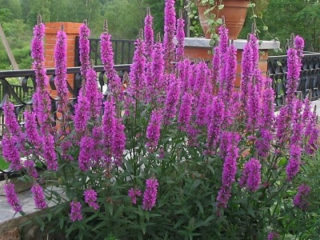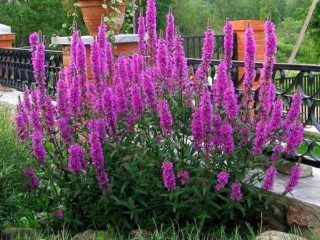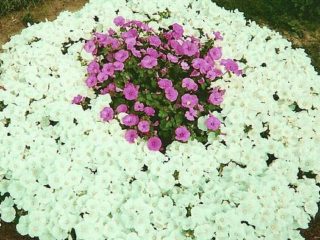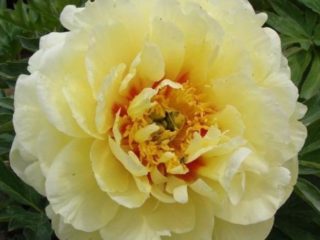Content
Some garden flowers attract with their exquisite simplicity. Loosestrife Pink pearls are perennials that do not immediately catch the eye, but look very attractive in compositions. Unpretentious cultivation, preservation of decorativeness throughout the growing season and exceptional endurance, make the plant popular with flower growers.
Description of willow loosestrife Pink pearl
Loosestrife (Lythrum Salicaria) fam. Derbennikovykh is a perennial herb with tetrahedral erect stems 0.5-1.5 m high. In the wild, it is found in all climatic zones of Russia, excluding the regions of the Far North. The merlin is hygrophilous, its bushes are found in the floodplains of rivers, in flooded meadows, along the shores of lakes and swamps.
The flower has a creeping root system located close to the surface of the earth. Over time, the rhizome becomes lignified. Bright green lanceolate leaf plates, located opposite or whorled, acquire a purple color by autumn.
The Pink Pearl variety is a herbaceous shrub 1-1.2 m high, with lilac-pink flowers densely located on paniculate inflorescences. Flowers in the form of toothed cups measuring 1 cm with 6-12 stamens are located in the axils of the bracts. The fruit is a bivalve capsule. Photo of a loosestrife Pink pearls during the flowering period amazes with their beauty.
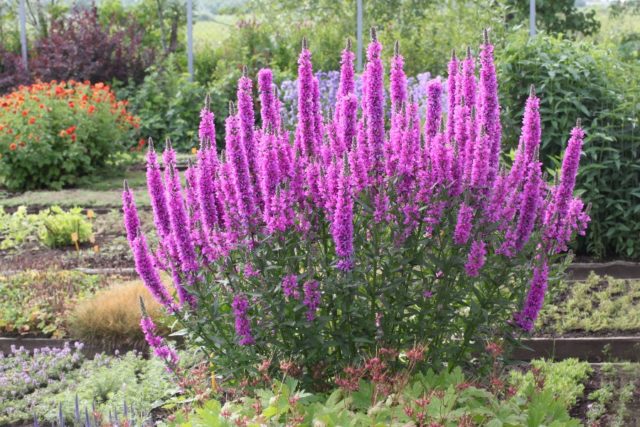
Loosestrife Pink pearl has numerous inflorescences up to 50 cm long
The loosestrife is unpretentious in care, is able to develop and bloom on any soil, easily tolerates frost and temperature changes. It can grow in one place without rejuvenation for more than 10 years. The bush received the popular name "plakun-grass" for the ability of the stomata located on the inside of the leaf to secrete excess moisture. In the morning, the plant is covered with water droplets. Being an excellent honey plant, the loosestrife actively attracts bees. All parts of the flower contain essential oils, flavonoids and glycosides. The loosestrife is used in folk medicine for diseases of the gastrointestinal tract, as an anti-inflammatory, sedative and diuretic.
Application in landscape design
The unpretentiousness of the loosestrife and the long flowering period (July-September) make the flower a valuable design element for mixborders, flower beds and flower beds. Along with the pink pearl loosestrife, other varieties are used to decorate flower beds.
Pink pearls go well with ornamental shrubs: chubushnik, spirea, vesicle and conifers. Derbennik successfully complements flower beds with daylilies, phlox, astilbe. In the lower tier of the plant, hosts, heucheras, and a decorative cuff are located.
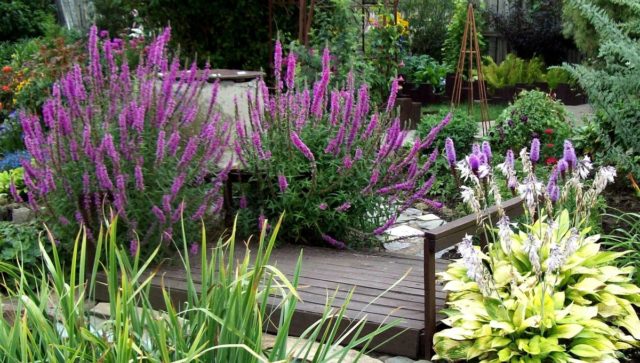
Bushes of Pink pearls in combination with decorative foliage plants
When designing the compositions, the ability of the loosestrife to grow strongly in width, suppressing the growth of weak plants, is taken into account. The bushes are planted with strong perennials: decorative grasses, liatris, chrysanthemums.
Derbennik Pink pearls are used to decorate artificial reservoirs, placed along the edges with iris-iris, sedge and miscanthus.The loosestrife can become part of a decorative pharmacy flower garden with other attractive medicinal plants: oregano, mint, echinacea and monarda.
Breeding features
Loosestrife Pink pearls can be propagated in several ways.
Rhizome division - in the process, lignified root areas are difficult to cut, you need to use an ax or a shovel. In this way, it is recommended to propagate young plants no older than 5 years. The event is held in spring or autumn, the resulting plants are planted at a distance of 50 cm from each other.
Cuttings - root cuttings are used, which are cut in June-July, planted for rooting in moist, loose soil. Seedlings are transplanted to a permanent place in early autumn.
The plant is easily propagated by seeds that you can harvest yourself. To improve the germination of the seed, it is necessary to undergo stratification. The seeds are placed in a refrigerator for a month or planted in open ground before winter. Young seedlings bloom 2-3 years after planting.
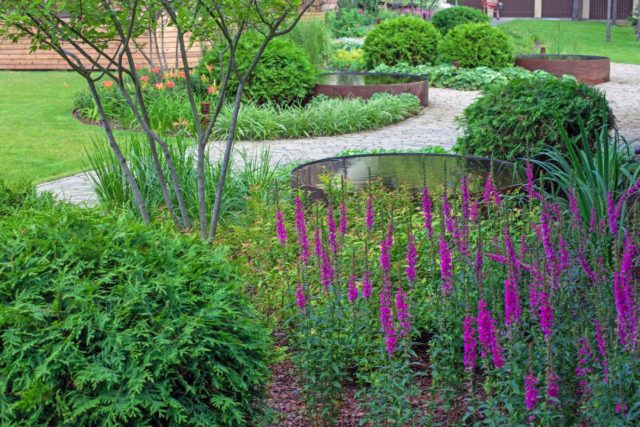
Young loosestrife seedlings look good against the background of other evergreen shrubs
Growing seedlings of loosestrife Pink pearls
Sowing seeds for seedlings is carried out in February-March. The prepared container is filled with a loose fertile substrate. Seeds are laid out on the surface of the soil, covered with a layer of soil of 2-3 mm. The landing box is covered with glass or plastic wrap, put in a bright place, and regularly ventilated.
At an optimum temperature of 15-18 ° C, the seeds germinate in 20-30 days, the polyethylene is removed. In the phase of 2-3 true leaves, the seedlings dive into separate small pots. Young seedlings are planted in open ground in May.
Planting and caring for a loosestrife Pink pearls in the ground
The peculiarities of plant cultivation are not difficult, any novice florist can grow a flower on his site. The plant thrives in sunny areas with moist soil. The planting site must be protected from strong winds that can break tall shoots.
Recommended timing
Planting and transplanting of a plant is carried out in April-early May or in autumn, after the end of flowering. Before the event, the peduncles with ovaries are cut, weak twigs are removed.
Site selection and preparation
Loosestrife Pink pearls can grow in any conditions. It is possible to achieve lush flowering and rapid growth of the curtain when planting a perennial in well-lit places with fertile, slightly acidic soil, pH -7-7.5. The flower does not develop well on sandy soils, which quickly lose moisture, prefers podzolic soils or peat bogs. The selected area is freed from weeds. Scanty soils are dug up with the addition of high-moor peat and well-rotted compost.
Landing algorithm
Properly prepared planting pits ensure the organic development of plants for many years.
Step-by-step instruction:
- dig holes in the soil 40 cm in width and depth;
- put 2-3 kg of compost or humus on the bottom;
- organic matter is mixed with fertile soil;
- rooted cuttings or cuttings 10 cm or more in size are planted in holes, evenly distributing the roots;
- the plants are sprinkled with earth, carefully watered, trying not to expose the root system.
Watering and feeding schedule
The merlin is a moisture-loving perennial that needs regular abundant watering. With a lack of moisture, the bush will not die, but the plant will not bloom.

The shrub grows well on wet soils near water bodies
Curtains of Pink Pearls are fed during the growing season: in the spring, before flowering, during, using complex mineral fertilizers. Organic fertilizing is carried out no more than once a year, the excess is harmful to the plant.
Weeding and loosening
Care should be taken to remove weeds and loosen the soil near the shrubbery. The root system of Pink Pearls is superficial and easy to damage. Mulching the near-trunk circle with peat solves several problems at once: it stops the growth of weeds, the need to loosen the soil disappears, moisture remains in the upper layer of the soil.
Pruning
The perennial is prone to self-seeding, the faded inflorescences are removed before the fruits ripen. In the fall, the aerial part is completely cut out. To increase the number of inflorescences in spring, young shoots are shortened by 15-20 cm. The lateral branches that appear emit a large number of peduncles, the plant blooms more actively.
Wintering
The loosestrife is characterized by increased winter hardiness. Even young bushes and plants do not need shelter after transplantation. Perennial perfectly tolerates frosts under the protection of a snow cover.
Diseases and pests
Herbaceous shrub Pink pearl has a high immunity, is practically not affected by fungal and viral diseases. The main pest is green and black aphids, which it is recommended to fight with folk remedies: infusion of garlic, onion husks, tobacco dust. The use of insecticides is undesirable on a honey plant - it can lead to the death of bees and bumblebees.
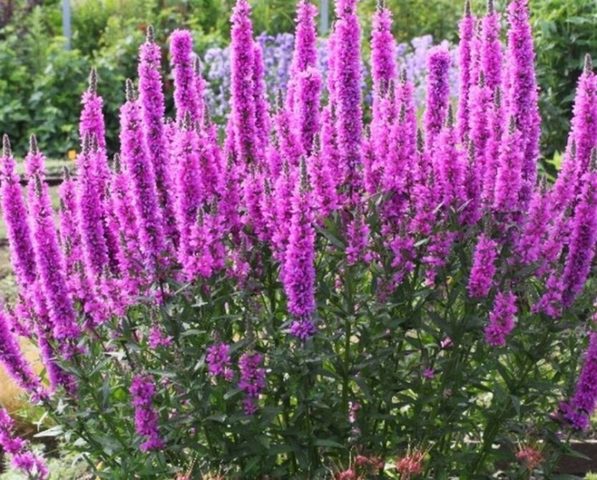
The bushes retain their decorative effect throughout the growing season.
Conclusion
Loosestrife Pink pearl is a perennial whose unassuming beauty serves as a wonderful background in a variety of compositions. Long paniculate inflorescences adorn the flower for more than three months a year, and crimson foliage refreshes the autumn landscape. The shrub is not capricious, it grows for many years, without bringing much trouble, without requiring increased attention.
Reviews of the loosestrife Pink pearl
